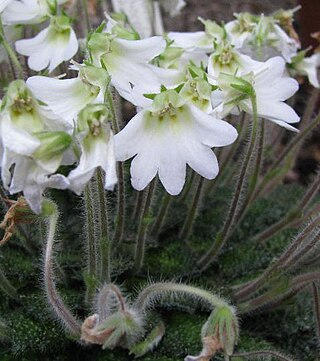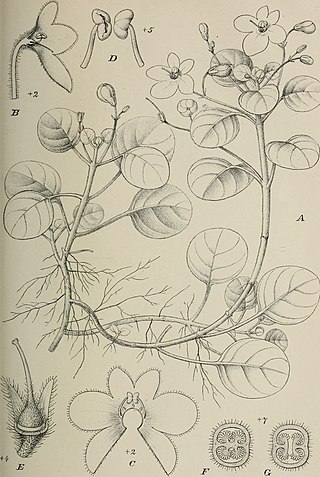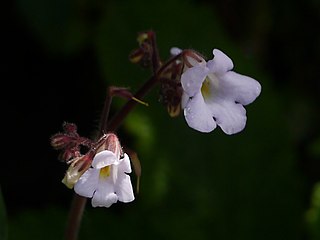
Gesneriaceae, the gesneriad family, is a family of flowering plants consisting of about 152 genera and ca. 3,540 species in the tropics and subtropics of the Old World and the New World, with a very small number extending to temperate areas. Many species have colorful and showy flowers and are cultivated as ornamental plants.
The African Violet Society of America (AVSA) is an international society of plant enthusiasts who promote the cultivation of African violets as house plants. The Society hosts an annual convention and publishes a bi-monthly full-color 64-page magazine, the African Violet Magazine.

Streptocarpus is an Afrotropical genus of flowering plants in the family Gesneriaceae. The genus is native to Afromontane biotopes from central, eastern and southern Africa, including Madagascar and the Comoro Islands. The flowers are five-petalled, salverform tubes, almost orchid-like in appearance, and hover or arch over the plant, while the pointed, elongate fruit is of a helical form similar to that of the "tusk" of a narwhal. In the wild, species can be found growing on shaded rocky hillsides or cliffs, on the ground, in rock crevices, and almost anywhere the seed can germinate and grow. For the home, there are now many hybrids of various colours and forms available.
Streptocarpus inconspicuus, synonym Saintpaulia inconspicua, is a species of Streptocarpus in the section Saintpaulia. It is a rare African violet, found in the Uluguru Mountains in Tanzania, East Africa. It was first formally described in 1958. It is classed as an endangered species by the IUCN Red List.

Petrocosmea is a genus of the family Gesneriaceae, the African violet family. Most of the species within this genus are endemic to high-altitude areas in Western China, although some are native to other parts of Asia. It is a rosette forming genus that generally grows on wet mossy rocks or forests.

Brian Laurence "Bill" Burtt FRSE FLS, was an English botanist and taxonomist who is noted for his contributions to the family Gesneriaceae. In a career that spanned 74 years, he worked first at the Royal Botanic Gardens, Kew, and then at the Royal Botanic Garden Edinburgh (RBGE). He made numerous field trips to South Africa and Sarawak and described a total of 637 new plant species. Burtt is denoted by the author abbreviation B.L.Burtt when citing a botanical name.

Streptocarpus rexii is a South African plant in the family Gesneriaceae, occurring widely from the southern Cape along the coastal hills, mountains, wooded ravines and valleys, and moist forests of the east coast, through Natal as far north as the Eastern Transvaal, up to an altitude of about 900 m. This genus of epiphytes and lithophytes, of about 130 species, is mainly African and Mascarene, with four vagrant species in Asia. Streptocarpus, as do other Old World Gesneriaceae, is unusual in that it displays anisocotylous or unequal growth, i.e. one cotyledon continues to grow after germination.

Streptocarpus goetzeanus, synonym Saintpaulia goetzeana, is a species of Streptocarpus in the section Saintpaulia, commonly known as an African violet. It is a small, flowering plant that is used widely in home horticulture. S. goetzeana was first collected in 1898 by W. Goetze, and it was later described as a species by Engler in 1900.

Primulina is a genus of flowering plants in the African violet family Gesneriaceae. In 2011 the genus was expanded with the transfer of many species that had previously been placed in the genus Chirita. In 2016, five species were moved to the genus Deinostigma.

Streptocarpus teitensis, synonym Saintpaulia teitensis, is a species of Streptocarpus in the section Saintpaulia. It is endemic to 1 square kilometer on Mbololo Hill in the Taita Hills of southern Kenya. The total population is estimated at less than 2,500 individual plants in the wild.

Streptocarpus shumensis, synonym Saintpaulia shumensis, is a species of Streptocarpus in the section Saintpaulia. It is endemic to Shume in the west Usambara Mountains and also from the northern Nguru Mountains, both in Tanzania, where it grows at elevations of 1,300 to 2,000 meters above sea level.

Henckelia is a genus of flowering plants in the family Gesneriaceae. Many of its species were formerly placed in Didymocarpus sect. Orthoboea and in the genus Chirita. Many species formerly placed in Henckelia have been moved to Codonoboea and Loxocarpus.

Streptocarpus ionanthus is a species of Streptocarpus in the section Saintpaulia, commonly known as an African violet. It is native to eastern and southwestern Tanzania.
Streptocarpus afroviola, synonym Saintpaulia pusilla, is a species of flowering plant in the family Gesneriaceae, native to Tanzania. It was first described in 1900 by Adolf Engler as Saintpaulia pusilla. The former genus Saintpaulia was reduced to Streptocarpus sect. Saintpaulia, and the species was moved to Streptocarpus. However, the name Streptocarpus pusillus had been used in 1883 for a different species, so Maarten J. M. Christenhusz put forward the replacement name Streptocarpus afroviola.
Streptocarpus albus is a species of flowering plant in the family Gesneriaceae, native to Tanzania. It was first described in 1933 as Saintpaulia alba. It is found in the Uluguru and Nguru mountains of Tanzania.

Streptocarpus brevipilosus is a species of flowering plant in the family Gesneriaceae, native to Tanzania. It was first described in 1964 as Saintpaulia brevipilosa. The former genus Saintpaulia was reduced to Streptocarpus sect. Saintpaulia in 2015, and the species moved to Streptocarpus. It is found in the Nguru Mountains of Tanzania.
Streptocarpus nitidus is a species of flowering plant in the family Gesneriaceae, native to Tanzania. It was first described in 1958 as Saintpaulia nitida. The former genus Saintpaulia was reduced to Streptocarpus sect. Saintpaulia in 2015, and the species moved to Streptocarpus. Streptocarpus nitidus has also been treated as a subspecies of Streptocarpus ionanthus.
Streptocarpus ulugurensis is a species of flowering plant in the family Gesneriaceae. It is an herbaceous perennial endemic to the Uluguru Mountains of Tanzania.
Loxostigma is a genus of flowering plants belonging to the family Gesneriaceae.
















